Predicting Streamflow and Nutrient Loadings in a Semi-Arid Mediterranean Watershed with Ephemeral Streams Using the SWAT Model
Abstract
1. Introduction
2. Materials and Methods
2.1. Study Area
2.2. Data Collection and Processing
2.2.1. DEM and River Network
2.2.2. Soil Data
2.2.3. Land Use and Agronomic Practices
2.2.4. Climate Data
2.2.5. River Discharge Data
2.2.6. Water Quality Data
2.3. The SWAT Model
2.3.1. Model Set-Up
2.3.2. Model Calibration and Validation
3. Results and Discussion
3.1. Calibration and Validation
3.1.1. Streamflow Calibration and Validation
3.1.2. Water Quality Calibration and Validation
3.1.3. Sensitive Parameters
3.2. Water Balance
3.3. Water Quality and High Loading Areas
4. Conclusions
Author Contributions
Funding
Acknowledgments
Conflicts of Interest
References
- Cammalleri, C.; Barbosa, P.; Micale, F.; Vogt, J.V. Climate Change Impacts and Adaptation in Europe, Focusing on Extremes and Adaptation until the 2030s. PESETA-3 Project, Final Sector Report on Task 9: Droughts; JRC European Commission: Ispra, Italy, 2017. [Google Scholar]
- Gamvroudis, C.; Nikolaidis, N.P.; Tzoraki, O.; Papadoulakis, V.; Karalemas, N. Water and sediment transport modeling of a large temporary river basin in Greece. Sci. Total Environ. 2015, 508, 354–365. [Google Scholar] [CrossRef]
- De Girolamo, A.M.; Bouraoui, F.; Buffagni, A.; Pappagallo, G.; Lo Porto, A. Hydrology under climate change in a temporary river system: Potential impact on water balance and flow regime. River Res. Appl. 2017, 33, 1219–1232. [Google Scholar] [CrossRef]
- Ricci, G.F.; De Girolamo, A.M.; Abdelwahab, O.M.M.; Gentile, F. Identifying sediment source areas in a Mediterranean watershed using the SWAT model. Land Degrad. Dev. 2018, 29, 1233–1248. [Google Scholar] [CrossRef]
- Serpa, D.; Nunes, J.P.; Santos, J.; Sampaio, E.; Jacinto, R.; Veiga, S.; Lima, J.C.; Moreira, M.; Corte-Real, J.; Keizer, J.J.; et al. Impacts of climate and land use changes on the hydrological and erosion processes of two contrasting Mediterranean catchments. Sci. Total Environ. 2015, 538, 64–77. [Google Scholar] [CrossRef] [PubMed]
- Sorando, R.; Comín, F.A.; Jiménez, J.J.; Sánchez-Pérez, J.M.; Sauvage, S. Water resources and nitrate discharges in relation to agricultural land uses in an intensively irrigated watershed. Sci. Total Environ. 2019, 659, 1293–1306. [Google Scholar] [CrossRef] [PubMed]
- Vermeulen, S.J.; Challinor, A.J.; Thornton, P.K.; Campbell, B.M.; Eriyagama, N.; Vervoort, J.M.; Kinyangi, J.; Jarvis, A.; Läderach, P.; Ramirez-Villegas, J.; et al. Addressing uncertainty in adaptation planning for agriculture. Proc. Natl. Acad. Sci. USA 2013, 110, 8357–8362. [Google Scholar] [CrossRef]
- Fava, F.; Pulighe, G.; Monteiro, A.T. Mapping Changes in Land Cover Composition and Pattern for Comparing Mediterranean Rangeland Restoration Alternatives. Land Degrad. Dev. 2016, 27, 671–681. [Google Scholar] [CrossRef]
- Raclot, D.; Le Bissonnais, Y.; Annabi, M.; Sabir, M.; Smetanova, A. Main Issues for Preserving Mediterranean Soil Resources From Water Erosion Under Global Change. Land Degrad. Dev. 2018, 29, 789–799. [Google Scholar] [CrossRef]
- Veldkamp, T.I.E.; Wada, Y.; de Moel, H.; Kummu, M.; Eisner, S.; Aerts, J.C.J.H.; Ward, P.J. Changing mechanism of global water scarcity events: Impacts of socioeconomic changes and inter-annual hydro-climatic variability. Glob. Environ. Chang. 2015, 32, 18–29. [Google Scholar] [CrossRef]
- Wolf, J.; Kanellopoulos, A.; Kros, J.; Webber, H.; Zhao, G.; Britz, W.; Reinds, G.J.; Ewert, F.; de Vries, W. Combined analysis of climate, technological and price changes on future arable farming systems in Europe. Agric. Syst. 2015, 140, 56–73. [Google Scholar] [CrossRef]
- Ponti, L.; Gutierrez, A.P.; Ruti, P.M.; Dell’Aquila, A. Fine-scale ecological and economic assessment of climate change on olive in the Mediterranean Basin reveals winners and losers. Proc. Natl. Acad. Sci. USA 2014, 111, 5598–5603. [Google Scholar] [CrossRef]
- Hussain, M.I.; Muscolo, A.; Farooq, M.; Ahmad, W. Sustainable use and management of non-conventional water resources for rehabilitation of marginal lands in arid and semiarid environments. Agric. Water Manag. 2019, 221, 462–476. [Google Scholar] [CrossRef]
- Dauber, J.; Miyake, S. To integrate or to segregate food crop and energy crop cultivation at the landscape scale? Perspectives on biodiversity conservation in agriculture in Europe. Energy Sustain. Soc. 2016, 6, 25. [Google Scholar] [CrossRef]
- Soldatos, P. Economic Aspects of Bioenergy Production from Perennial Grasses in Marginal Lands of South Europe. Bioenergy Res. 2015, 8, 1562–1573. [Google Scholar] [CrossRef]
- Anderson-Teixeira, K.J.; Duval, B.D.; Long, S.P.; DeLucia, E.H. Biofuels on the landscape: Is “land sharing” preferable to “land sparing”? Ecol. Appl. 2012, 22, 2035–2048. [Google Scholar] [CrossRef]
- The Global Bioenergy Partnership (GBEP). Available online: http://www.globalbioenergy.org (accessed on 30 September 2019).
- Alexopoulou, E.; Zanetti, F.; Scordia, D.; Zegada-Lizarazu, W.; Christou, M.; Testa, G.; Cosentino, S.L.; Monti, A. Long-Term Yields of Switchgrass, Giant Reed, and Miscanthus in the Mediterranean Basin. BioEnergy Res. 2015, 8, 1492–1499. [Google Scholar] [CrossRef]
- Testa, R.; Foderà, M.; Maria, A.; Trapani, D.; Tudisca, S.; Sgroi, F. Giant reed as energy crop for Southern Italy: An economic feasibility study. Renew. Sustain. Energy Rev. 2016, 58, 558–564. [Google Scholar] [CrossRef]
- European Commission. Proposal for a DIRECTIVE OF THE EUROPEAN PARLIAMENT AND OF THE COUNCIL on the Promotion of the Use of Energy from Renewable Sources (Recast). COM/2016/0767 Final/2—2016/0382 (COD); European Commission: Bruxelles, Belgium, 2017. [Google Scholar]
- Pulighe, G.; Bonati, G.; Colangeli, M.; Morese, M.M.; Traverso, L.; Lupia, F.; Khawaja, C.; Janssen, R.; Fava, F. Ongoing and emerging issues for sustainable bioenergy production on marginal lands in the Mediterranean regions. Renew. Sustain. Energy Rev. 2019, 103, 58–70. [Google Scholar] [CrossRef]
- Fu, B.; Merritt, W.S.; Croke, B.F.W.; Weber, T.R.; Jakeman, A.J. A review of catchment-scale water quality and erosion models and a synthesis of future prospects. Environ. Model. Softw. 2019, 114, 75–97. [Google Scholar] [CrossRef]
- Arnold, J.G.; Moriasi, D.N.; Gassman, P.W.; Abbaspour, K.C.; White, M.J.; Srinivasan, R.; Santhi, C.; Harmel, R.D.; van Griensven, A.; Van Liew, M.W.; et al. SWAT: Model Use, Calibration, and Validation. Trans. ASABE 2012, 55, 1491–1508. [Google Scholar] [CrossRef]
- Gassman, P.W.; Sadeghi, A.M.; Srinivasan, R. Applications of the SWAT Model Special Section: Overview and Insights. J. Environ. Qual. 2014, 43, 1. [Google Scholar] [CrossRef]
- Winchell, M.; Srinivasan, R.; Di Luzio, M.; Arnold, J.G. Arcswat Interface for SWAT2012: User’s Guide; Blackland Research & Extension Center, Texas Agrilife Research: Temple, TX, USA, 2013. [Google Scholar]
- Panagopoulos, Y.; Makropoulos, C.; Kossida, M.; Mimikou, M. Optimal Implementation of Irrigation Practices: Cost-Effective Desertification Action Plan for the Pinios Basin. J. Water Resour. Plan. Manag. 2014, 140, 05014005. [Google Scholar] [CrossRef]
- Molina-Navarro, E.; Andersen, H.E.; Nielsen, A.; Thodsen, H.; Trolle, D. The impact of the objective function in multi-site and multi-variable calibration of the SWAT model. Environ. Model. Softw. 2017, 93, 255–267. [Google Scholar] [CrossRef]
- Di Lucia, L.; Usai, D.; Woods, J. Designing landscapes for sustainable outcomes—The case of advanced biofuels. Land Use Policy 2018, 73, 434–446. [Google Scholar] [CrossRef]
- Pulighe, G.; Bonati, G.; Fabiani, S.; Barsali, T.; Lupia, F.; Vanino, S.; Nino, P.; Arca, P.; Roggero, P. Assessment of the Agronomic Feasibility of Bioenergy Crop Cultivation on Marginal and Polluted Land: A GIS-Based Suitability Study from the Sulcis Area, Italy. Energies 2016, 9, 895. [Google Scholar] [CrossRef]
- De Girolamo, A.M.; Lo Porto, A. Land use scenario development as a tool for watershed management within the Rio Mannu Basin. Land Use Policy 2012, 29, 691–701. [Google Scholar] [CrossRef]
- Climate Forecast System Reanalysis (CFSR); The National Centers for Environmental Prediction (NCEP), Texas Agrilife Research: Temple, TX, USA, 2019.
- RAS Regione Autonoma della Sardegna—Sardegna Geoportale. Available online: http://www.sardegnageoportale.it/index.php?xsl=1594&s=40&v=9&c=8753&n=10 (accessed on 30 January 2019).
- RAS Regione Autonoma della Sardegna—Agenzia AGRIS—Portale del Suolo. Available online: http://www.sardegnaportalesuolo.it (accessed on 30 January 2019).
- RAS Regione Autonoma della Sardegna—Studio dell’Idrologia Superficiale della Sardegna (SISS). Available online: http://pcserver.unica.it/web/sechi/main/Corsi/Didattica/IDROLOGIA/DatiSISS/index.htm (accessed on 30 January 2019).
- RAS Regione Autonoma della Sardegna—Centro di documentazione dei bacini idrografici (CEDOC). Available online: http://82.85.20.58/sardegna/webapp/index.php (accessed on 30 January 2019).
- RAS Regione Autonoma della Sardegna—Disciplinari di Produzione Integrata delle colture, annualità 2019. Available online: https://www.regione.sardegna.it/j/v/2644?s=1&v=9&c=390&c1=1305&id=78067 (accessed on 30 January 2019).
- Chaplot, V. Impact of DEM mesh size and soil map scale on SWAT runoff, sediment, and NO3–N loads predictions. J. Hydrol. 2005, 312, 207–222. [Google Scholar] [CrossRef]
- Soil Survey Staff Keys to Soil Taxonomy, 8th ed.; USDA-NRCS, United States Government Printing Office: Washington, DC, USA, 1998.
- USDA Soil-Plant-Air-Water (SPAW) model—United States Department of Agriculture. Available online: https://www.nrcs.usda.gov/wps/portal/nrcs/detailfull/national/?&cid=stelprdb1045331 (accessed on 30 March 2019).
- Saxton, K.E.; Rawls, W.J. Soil Water Characteristic Estimates by Texture and Organic Matter for Hydrologic Solutions. Soil Sci. Soc. Am. J. 2006, 70, 1569. [Google Scholar] [CrossRef]
- EEA European Environment Agency. The CORINE Land Cover (CLC) Inventory. Available online: http://land.copernicus.eu/pan-european/corine-land-cover (accessed on 2 April 2019).
- Capri, S.; Pagnotta, R.; Pettine, M.; Belli, M.; Centioli, D.; Dezorzi, D.; Sansone, S. Metodi Analitici Per Le Acque. In APAT, Manuali e Linee Guida 29/2003; APAT, R. 29/2003; APAT: Rome, Italy, 2003; ISBN 88-448-0083-7. [Google Scholar]
- Schleppi, P.; Waldner, P.A.; Fritschi, B. Accuracy and precision of different sampling strategies and flux integration methods for runoff water: Comparisons based on measurements of the electrical conductivity. Hydrol. Process. 2006, 20, 395–410. [Google Scholar] [CrossRef]
- SCS Section 4, Hydrology. In National Engineering Handbook; US Government Printing Office: Washington, DC, USA, 1972; p. 544.
- Winnaar, G.; Jewitt, G.P.W.; Horan, M. A GIS-based approach for identify-ing potential runoff harvesting sites in the Thukela River basin, South Africa. Phys. Chem. Earth 2007, 34, 767–775. [Google Scholar]
- Williams, J.R. Sediment-yield prediction with Universal Equation using runoff energy factor. In Present and Prospective Technology for Predicting Sediment Yield and Sources; U.S. Dep. Agr. ARS-S40.: Washington, DC, USA, 1975; pp. 244–252. [Google Scholar]
- Brown, L.C.; Barnwell, T. The Enhanced Stream Water Quality Models QUAL2E and QUAL2E-UNCAS: Documentation and User Manual; U.S. Environmental Protection Agency (EPA): Athens, GA, USA, 1987.
- Arnold, J.R.; Kiniry, J.R.; Srinivasan, R.; Williams, J.R.; Haney, E.B.; Neitsch, S.L. Soil & Water Assessment Tool—Input/Output Documentation Version 2012; Texas Water Resources Institute: Forney, TX, USA, 2012. [Google Scholar]
- Runkel, R.L.; Crawford, C.G.; Cohn, T.A. Load Estimator (LOADEST): A FORTRAN Program for Estimating Constituent Loads in Streams and Rivers. In Techniques and Methods Book 4-A5: U.S. Geological Survey; CreateSpace Independent Publishing Platform: North Charleston, SC, USA, 2004. [Google Scholar]
- Biondi, D.; Freni, G.; Iacobellis, V.; Mascaro, G.; Montanari, A. Validation of hydrological models: Conceptual basis, methodological approaches and a proposal for a code of practice. Phys. Chem. Earth 2012, 42–44, 70–76. [Google Scholar] [CrossRef]
- Gupta, H.V.; Kling, H.; Yilmaz, K.K.; Martinez, G.F. Decomposition of the mean squared error and NSE performance criteria: Implications for improving hydrological modelling. J. Hydrol. 2009, 377, 80–91. [Google Scholar] [CrossRef]
- Moriasi, D.N.; Gitau, M.W.; Pai, N.; Daggupati, P. Hydrologic and Water Quality Models: Performance Measures and Evaluation Criteria. Trans. ASABE 2015, 58, 1763–1785. [Google Scholar]
- Moriasi, D.N.; Arnold, J.G.; Van Liew, M.W.; Bingner, R.L.; Harmel, R.D.; Veith, T.L. Model evaluation guidelines for systematic quantification of accuracy in watershed simulations. Trans. ASABE 2007, 50, 885–900. [Google Scholar] [CrossRef]
- Zambrano-Bigiarini, M. hydroGOF: Goodness-of-fit functions for comparison of simulated and observed hydrological time series. In R Package Version 0.3-10; 2017; Available online: http://hzambran.github.io/hydroGOF/ (accessed on 16 December 2019). [CrossRef]
- Abbaspour, K.C.; Yang, J.; Maximov, I.; Siber, R.; Bogner, K.; Mieleitner, J.; Zobrist, J.; Srinivasan, R. Modelling hydrology and water quality in the pre-alpine/alpine Thur watershed using SWAT. J. Hydrol. 2007, 333, 413–430. [Google Scholar] [CrossRef]
- Knoben, W.J.M.; Freer, J.E.; Woods, R.A. Technical note: Inherent benchmark or not? Comparing Nash-Sutcliffe and Kling-Gupta efficiency scores. Hydrol. Earth Syst. Sci. 2019, 23, 4323–4331. [Google Scholar] [CrossRef]
- Abbaspour, K.C.; Vaghefi, S.A.; Srinivasan, R. A guideline for successful calibration and uncertainty analysis for soil and water assessment: A review of papers from the 2016 international SWAT conference. Water 2017, 10, 6. [Google Scholar] [CrossRef]
- Panagopoulos, Y.; Makropoulos, C.; Baltas, E.; Mimikou, M. SWAT parameterization for the identification of critical diffuse pollution source areas under data limitations. Ecol. Model. 2011, 222, 3500–3512. [Google Scholar] [CrossRef]
- Rivas-Tabares, D.; Tarquis, A.M.; Willaarts, B.; De Miguel, Á. An accurate evaluation of water availability in sub-arid Mediterranean watersheds through SWAT: Cega-Eresma-Adaja. Agric. Water Manag. 2019, 212, 211–225. [Google Scholar] [CrossRef]
- Abbaspour, K.C.; Rouholahnejad, E.; Vaghefi, S.; Srinivasan, R.; Yang, H.; Kløve, B. A continental-scale hydrology and water quality model for Europe: Calibration and uncertainty of a high-resolution large-scale SWAT model. J. Hydrol. 2015, 524, 733–752. [Google Scholar] [CrossRef]
- Chen, H.; Luo, Y.; Potter, C.; Moran, P.J.; Grieneisen, M.L.; Zhang, M. Modeling pesticide diuron loading from the San Joaquin watershed into the Sacramento-San Joaquin Delta using SWAT. Water Res. 2017, 121, 374–385. [Google Scholar] [CrossRef] [PubMed]
- Ouessar, M.; Bruggeman, A.; Abdelli, F.; Mohtar, R.H.; Gabriels, D.; Cornelis, W.M. Modelling water-harvesting systems in the arid south of Tunisia using SWAT. Hydrol. Earth Syst. Sci. 2009, 13, 2003–2021. [Google Scholar] [CrossRef]
- Muhammad, A.; Evenson, G.R.; Stadnyk, T.A.; Boluwade, A.; Jha, S.K.; Coulibaly, P. Impact of model structure on the accuracy of hydrological modeling of a Canadian Prairie watershed. J. Hydrol. Reg. Stud. 2019, 21, 40–56. [Google Scholar] [CrossRef]
- Taylor, S.D.; He, Y.; Hiscock, K.M. Modelling the impacts of agricultural management practices on river water quality in Eastern England. J. Environ. Manag. 2016, 180, 147–163. [Google Scholar] [CrossRef] [PubMed]
- Syvitski, J.P.M. Supply and flux of sediment along hydrological pathways: Research for the 21st century. Glob. Planet. Chang. 2003, 39, 1–11. [Google Scholar] [CrossRef]
- Zeiger, S.J.; Hubbart, J.A. A SWAT model validation of nested-scale contemporaneous stream flow, suspended sediment and nutrients from a multiple-land-use watershed of the central USA. Sci. Total Environ. 2016, 572, 232–243. [Google Scholar] [CrossRef]
- Pulighe, G.; Vanino, S.; Lupia, F.; Altobelli, F. Spatialised agricultural nitrogen balance of veneto region, northern italy: Sources identification, assessment and policy relevance. Glob. Nest J. 2014, 16, 294–306. [Google Scholar]
- Verheijen, F.G.A.; Jones, R.J.A.; Rickson, R.J.; Smith, C.J. Tolerable versus actual soil erosion rates in Europe. Earth-Sci. Rev. 2009, 94, 23–38. [Google Scholar] [CrossRef]
- Panagos, P.; Borrelli, P.; Poesen, J.; Ballabio, C.; Lugato, E.; Meusburger, K.; Montanarella, L.; Alewell, C. The new assessment of soil loss by water erosion in Europe. Environ. Sci. Policy 2015, 54, 438–447. [Google Scholar] [CrossRef]
- Nerantzaki, S.D.; Giannakis, G.V.; Efstathiou, D.; Nikolaidis, N.P.; Sibetheros, I.A.; Karatzas, G.P.; Zacharias, I. Modeling suspended sediment transport and assessing the impacts of climate change in a karstic Mediterranean watershed. Sci. Total Environ. 2015, 538, 288–297. [Google Scholar] [CrossRef]
- De Girolamo, A.M.; Miscioscia, P.; Politi, T.; Barca, E. Improving grey water footprint assessment: Accounting for uncertainty. Ecol. Indic. 2019, 102, 822–833. [Google Scholar] [CrossRef]
- De Girolamo, A.M.; Spanò, M.; D’Ambrosio, E.; Ricci, G.F.; Gentile, F. Developing a nitrogen load apportionment tool: Theory and application. Agric. Water Manag. 2019, 226, 105806. [Google Scholar] [CrossRef]
- Carvalho-Santos, C.; Nunes, J.P.; Monteiro, A.T.; Hein, L.; Honrado, J.P. Assessing the effects of land cover and future climate conditions on the provision of hydrological services in a medium-sized watershed of Portugal. Hydrol. Process. 2016, 30, 720–738. [Google Scholar] [CrossRef]
- Boongaling, C.G.K.; Faustino-Eslava, D.V.; Lansigan, F.P. Modeling land use change impacts on hydrology and the use of landscape metrics as tools for watershed management: The case of an ungauged catchment in the Philippines. Land Use Policy 2018, 72, 116–128. [Google Scholar] [CrossRef]
- Lee, S.; Yeo, I.Y.; Sadeghi, A.M.; McCarty, G.W.; Hively, W.D.; Lang, M.W. Impacts of watershed characteristics and crop rotations on winter cover crop nitrate-nitrogen uptake capacity within agricultural watersheds in the Chesapeake Bay region. PLoS ONE 2016, 11, e0157637. [Google Scholar] [CrossRef] [PubMed]
- Horowitz, A.J. Determining annual suspended sediment and sediment-associated trace element and nutrient fluxes. Sci. Total Environ. 2008, 400, 315–343. [Google Scholar] [CrossRef]
- Soana, E.; Bartoli, M.; Milardi, M.; Fano, E.A.; Castaldelli, G. An ounce of prevention is worth a pound of cure: Managing macrophytes for nitrate mitigation in irrigated agricultural watersheds. Sci. Total Environ. 2019, 647, 301–312. [Google Scholar] [CrossRef]
- Lassaletta, L.; Romero, E.; Billen, G.; Garnier, J.; García-Gómez, H.; Rovira, J.V. Spatialized N budgets in a large agricultural Mediterranean watershed: High loading and low transfer. Biogeosciences 2012, 9, 57–70. [Google Scholar] [CrossRef]
- Fernando, A.L.; Costa, J.; Barbosa, B.; Monti, A.; Rettenmaier, N. Environmental impact assessment of perennial crops cultivation on marginal soils in the Mediterranean Region. Biomass Bioenergy 2018, 111, 174–186. [Google Scholar] [CrossRef]
- Chen, Y.; Ale, S.; Rajan, N.; Morgan, C.L.S.; Park, J. Hydrological responses of land use change from cotton (Gossypium hirsutum L.) to cellulosic bioenergy crops in the Southern High Plains of Texas, USA. GCB Bioenergy 2016, 8, 981–999. [Google Scholar] [CrossRef]
- Christopher, S.F.; Schoenholtz, S.H.; Nettles, J.E. Water quantity implications of regional-scale switchgrass production in the southeastern U.S. Biomass Bioenergy 2015, 83, 50–59. [Google Scholar] [CrossRef]
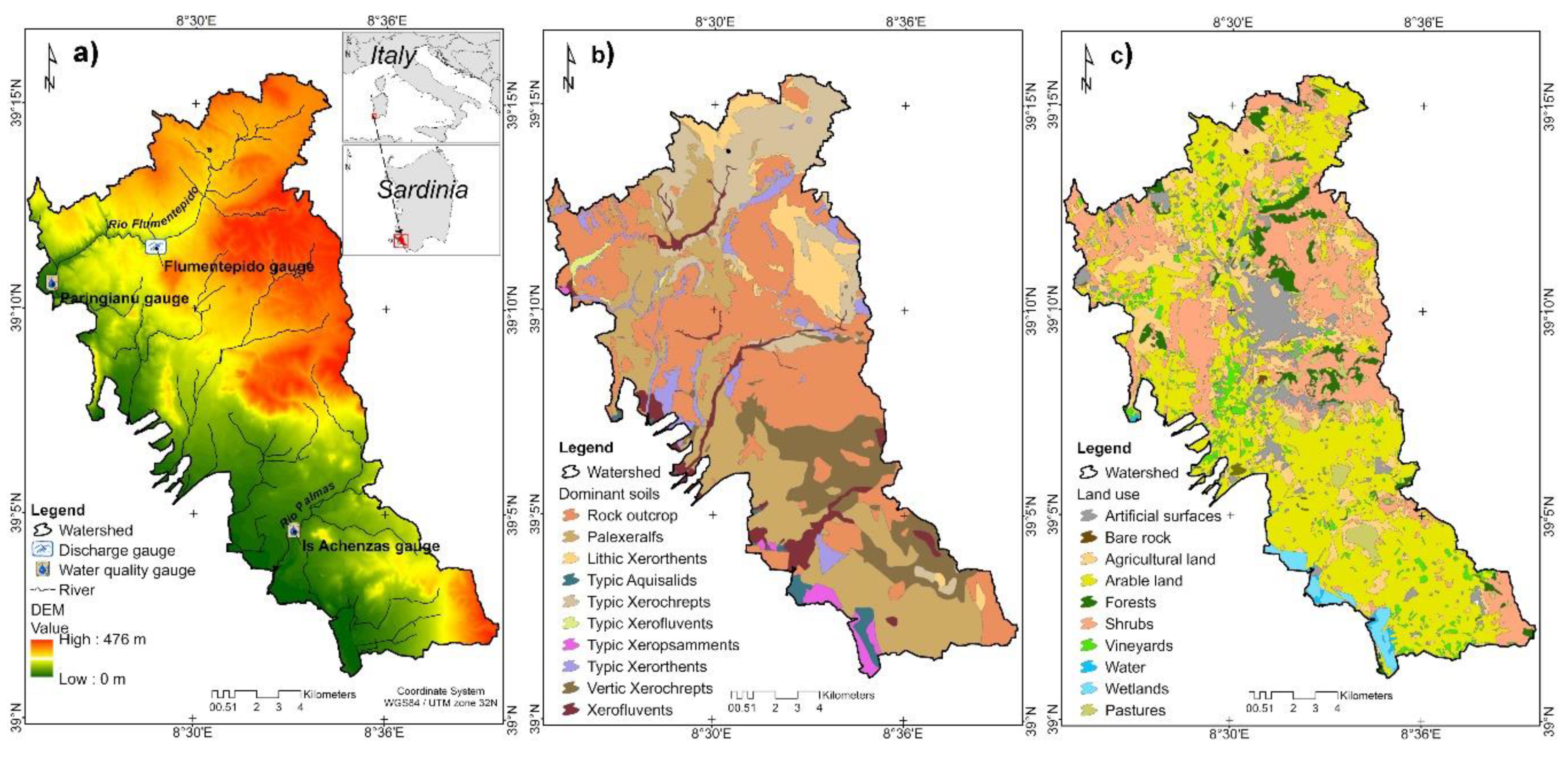
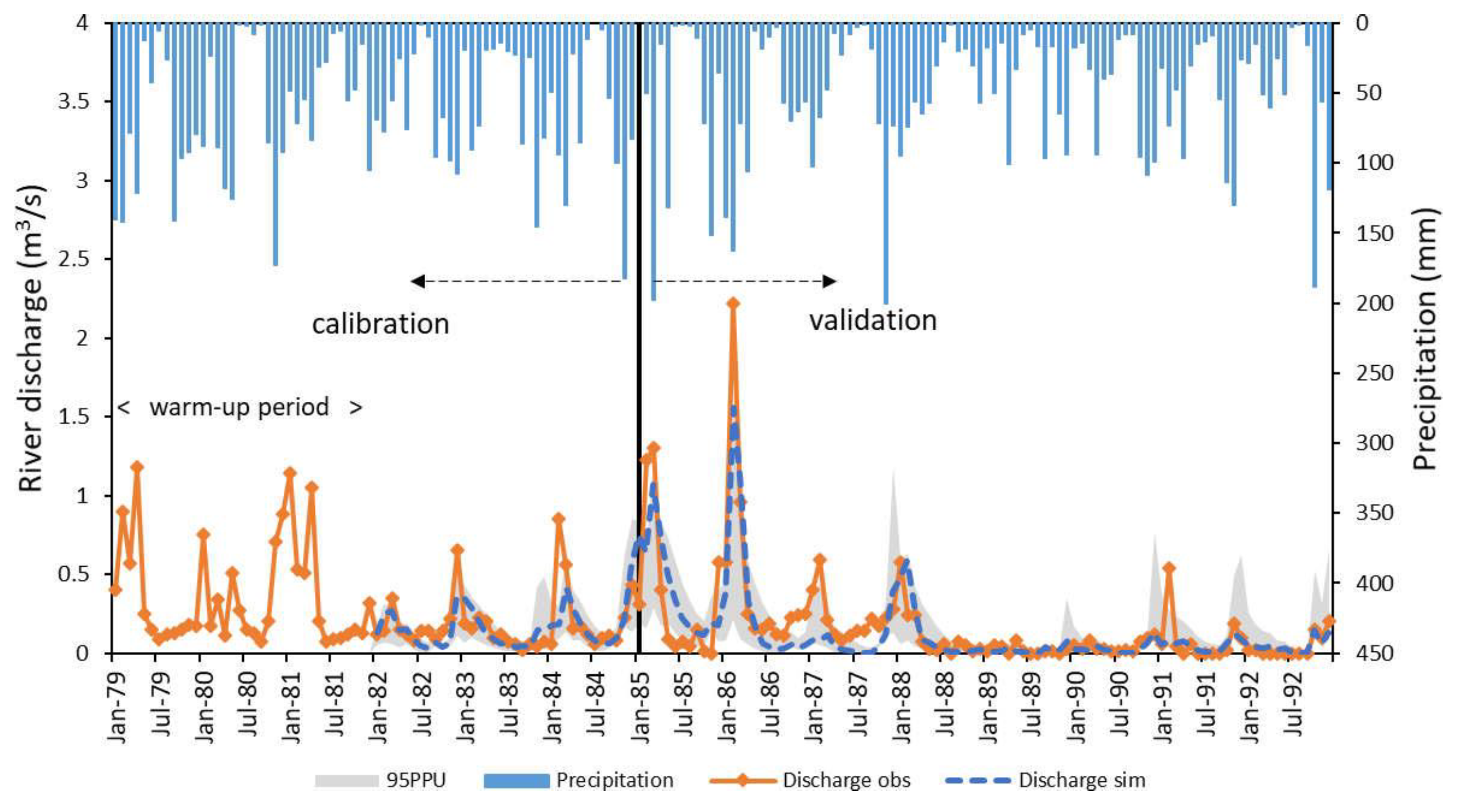
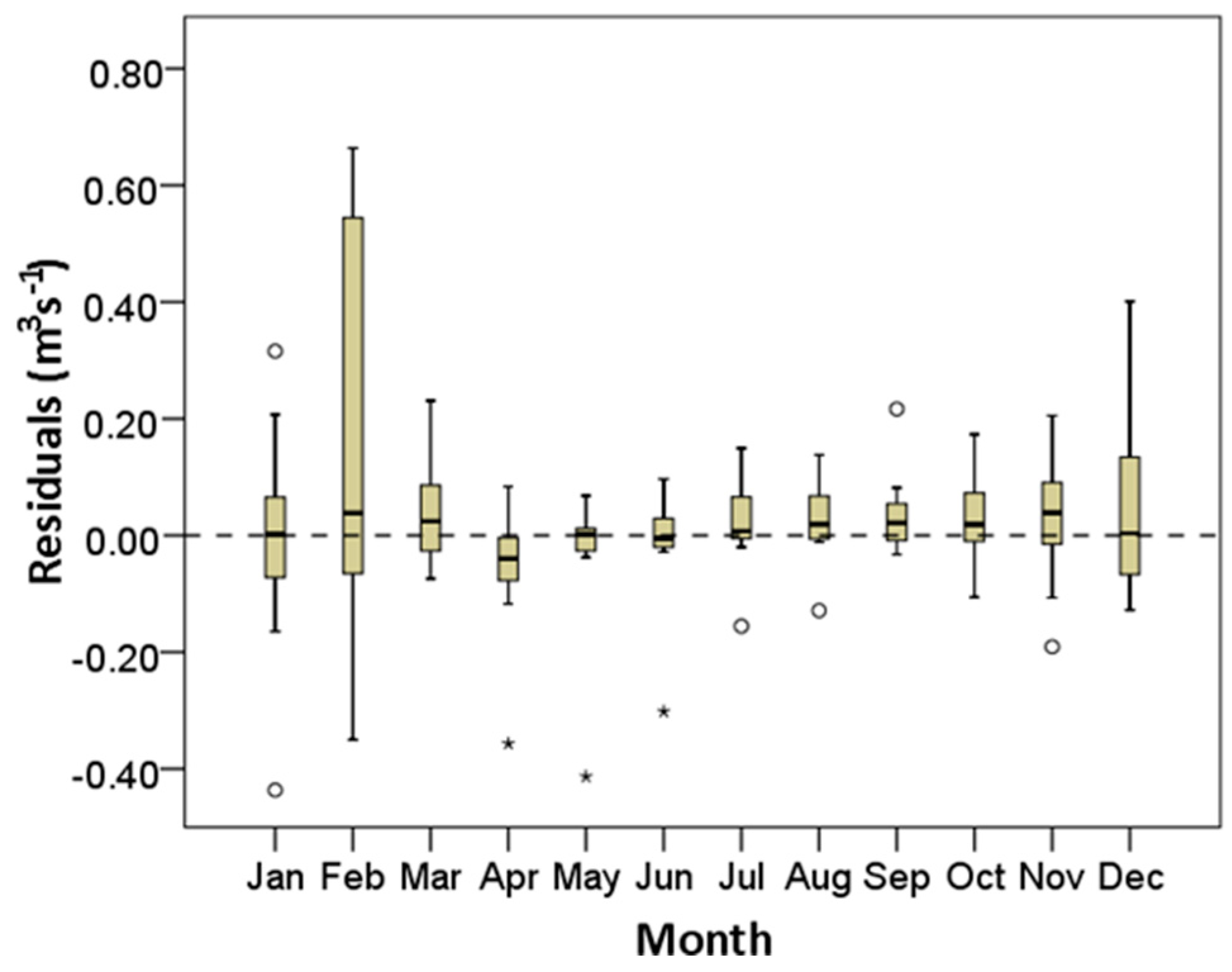
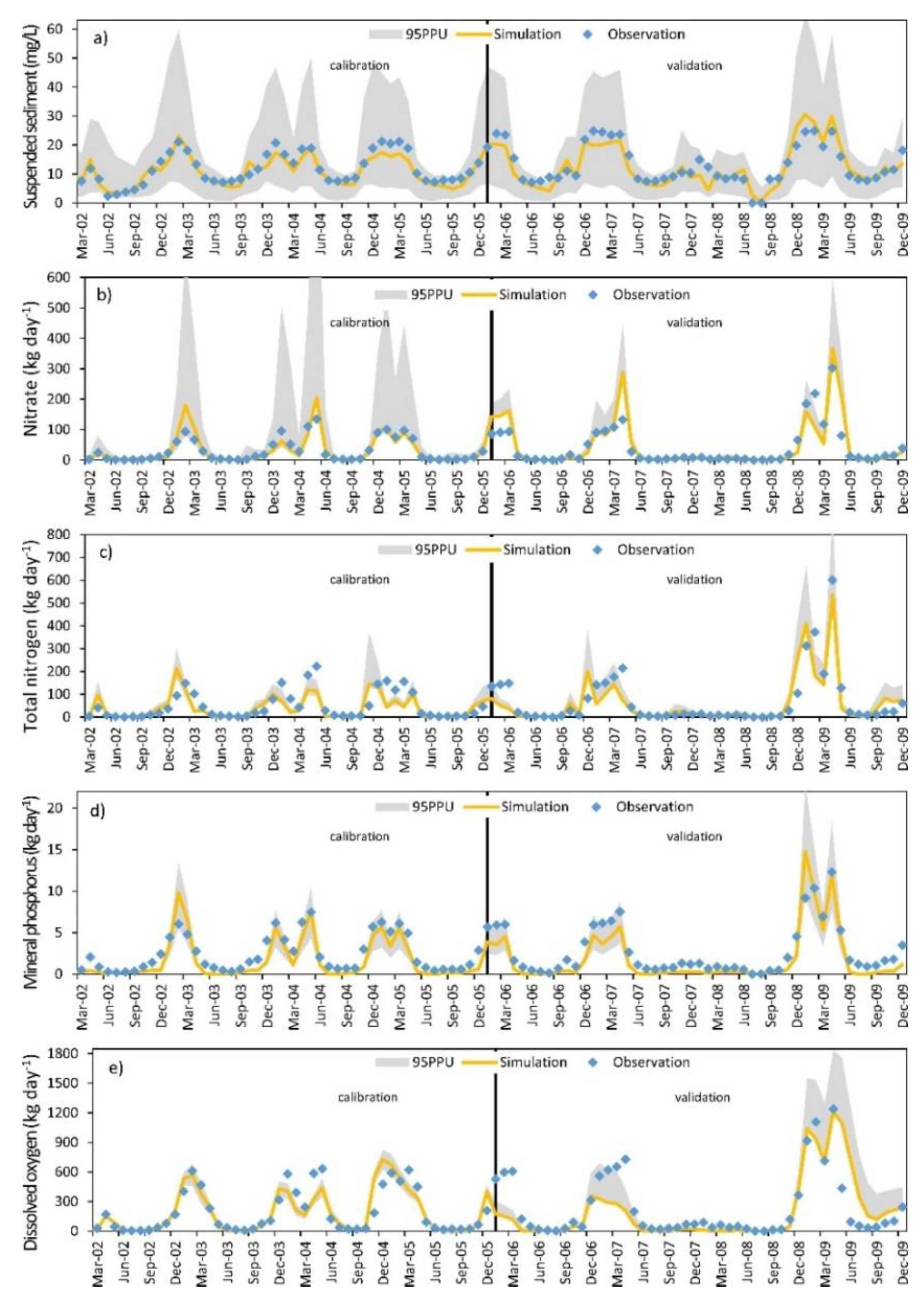
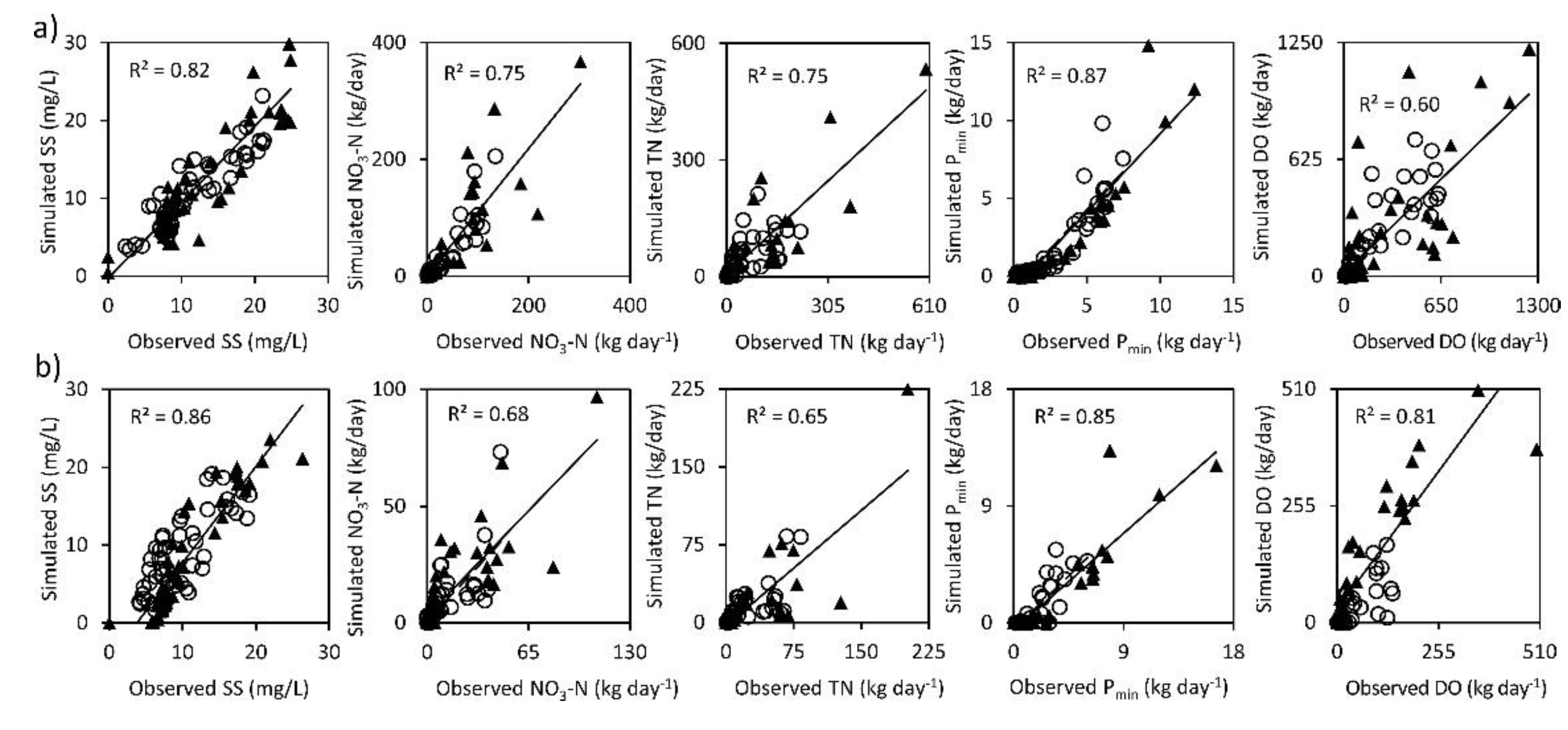
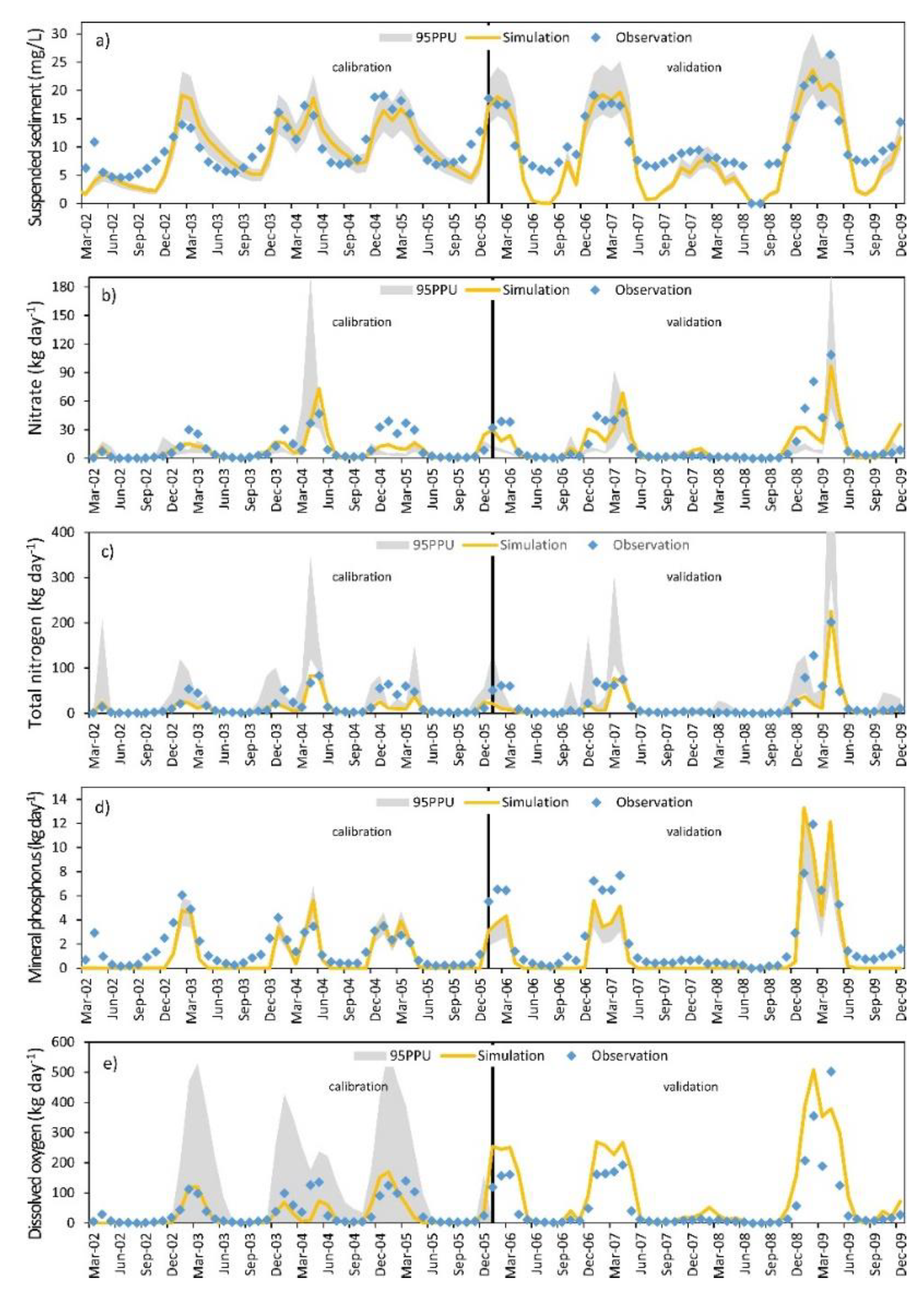
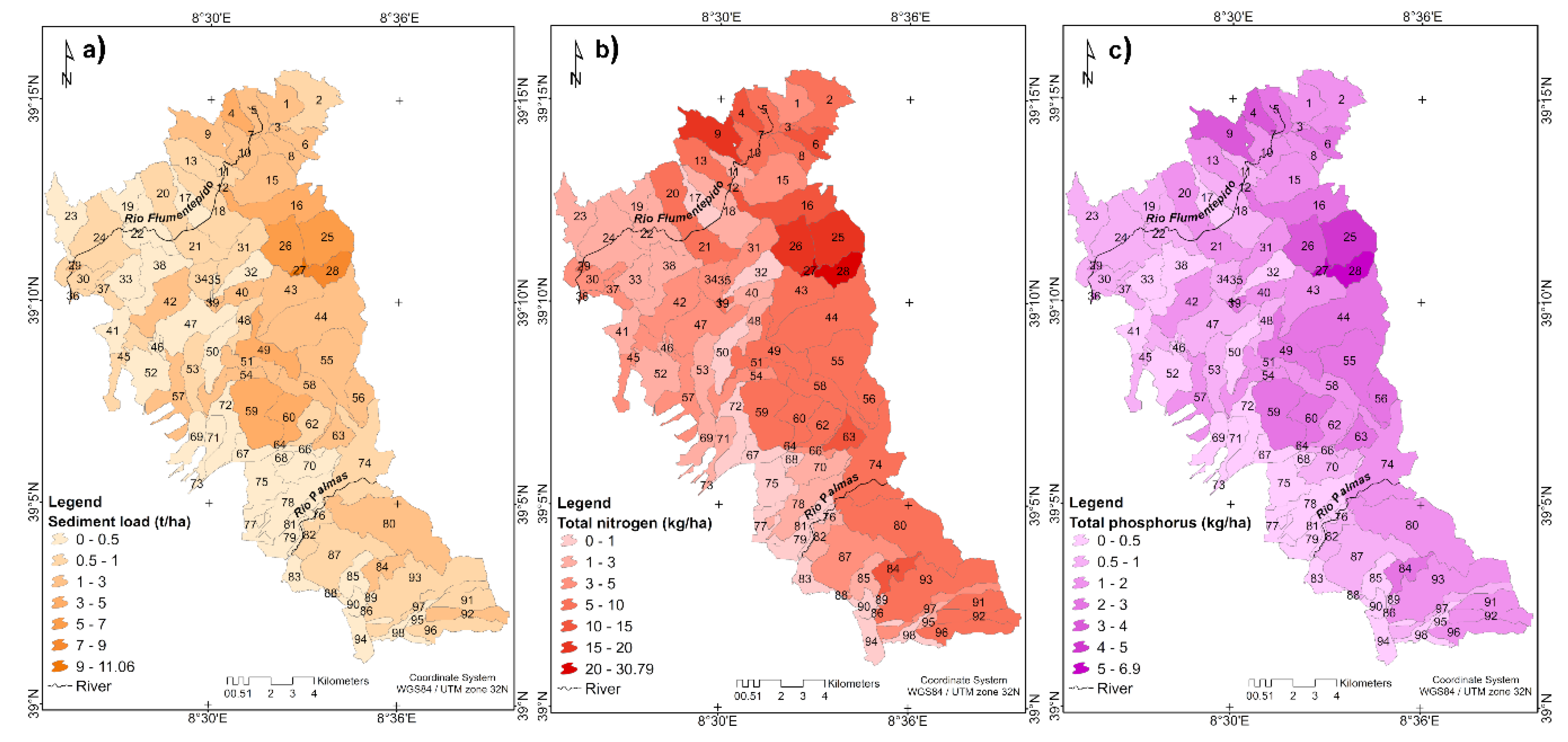
| Data Type | Scale/Resolution | Data Description | Source |
|---|---|---|---|
| DEM | 10 m | Elevation and slope elements | [32] |
| Soil data | 1:50,000 | Geographical representation and description of soil units and soil properties | [33] 1 |
| River network | 1:10,000 | High resolution geometry structure of stream reaches | [32] |
| Land use map | 1:25,000 | Spatial information on different types of physical coverage of the watershed | [32] |
| Weather data | 4 stations, ~38 km Years 1979–2009 | Rainfall, temperature, wind speed, solar radiation, and relative humidity | [31] |
| River discharge | Monthly (m3 s−1) Years 1979–1992 | River discharge as a volume of water flowing through a gauge station. Rio Flumentepido gauge station | [34] |
| Water quality data | Monthly (mg L−1) Years 2002–2009 | Suspended sediment, nitrate-nitrogen, total nitrogen, mineral phosphorus, and dissolved oxygen. Paringianu and Is Achenzas gauge stations | [35] |
| Agriculture management practices | Country level kg ha−1 | Application rate for fertilizers | [36] |
| Gauge Station | Calibration | Validation | ||||||
|---|---|---|---|---|---|---|---|---|
| NSE | RSR | PBIAS | KGE | NSE | RSR | PBIAS | KGE | |
| Flumentepido (Rio Flumentepido) | ||||||||
| discharge | 0.50 | 0.71 | 2.2% | 0.69 | 0.70 | 0.55 | 18.7% | 0.60 |
| Paringianu (Rio Flumentepido) | ||||||||
| sediments | 0.81 | 0.43 | 7.4% | 0.84 | 0.78 | 0.47 | 4.5% | 0.87 |
| nitrate-nitrogen | 0.71 | 0.54 | −1.7% | 0.73 | 0.60 | 0.63 | −12.1% | 0.69 |
| total nitrogen | 0.44 | 0.75 | 16.6% | 0.62 | 0.74 | 0.51 | 13.2% | 0.79 |
| mineral phosphorus | 0.68 | 0.57 | 31.6% | 0.66 | 0.76 | 0.49 | 32.2% | 0.66 |
| dissolved oxygen | 0.76 | 0.49 | 2.6% | 0.87 | 0.53 | 0.68 | 15.4% | 0.73 |
| Is Achenzas (Rio Palmas) | ||||||||
| sediments | 0.42 | 0.76 | 8.3% | 0.71 | 0.55 | 0.67 | 19% | 0.61 |
| nitrate-nitrogen | 0.47 | 0.73 | 19.2% | 0.68 | 0.67 | 0.57 | 11.3% | 0.74 |
| total nitrogen | 0.48 | 0.72 | 36.4% | 0.52 | 0.58 | 0.65 | 39.7 | 0.55 |
| mineral phosphorus | 0.42 | 0.76 | 42.9% | 0.53 | 0.77 | 0.48 | 38.5% | 0.59 |
| dissolved oxygen 1 | 0.50 | 0.71 | 22.8% | 0.67 | 0.55 | 0.67 | − | 0.42 |
| Parameter | Model Process | Description | Unit | Calibration Range |
|---|---|---|---|---|
| ALPHA_BH | Water flow | Baseflow recession constant | day | 0.71–1.04 |
| CN2.mgt | Water flow | Initial SCS runoff curve number for moisture condition | − | 36.4–44.6 |
| ESCO.hru | Water flow | Soil evaporation compensation factor | − | 0.24–0.25 |
| GW_DELAY.gw | Water flow | Groundwater delay time | day | 22.5–25.8 |
| GW_REVAP.gw | Water flow | Groundwater re-evaporation coefficient | − | 0.02–0.04 |
| GWQMIN.gw | Water flow | Threshold depth of water in the shallow aquifer required for return flow to occur | mm | 463.9–1129.5 |
| RCHRG_DP.gw | Water flow | Deep aquifer percolation fraction | − | 0.18–0.49 |
| SPCON.bsn | Sediment | Linear parameter for channel sediment routing | − | 0–0.0009 |
| SPEXP.bsn | Sediment | Exponent parameter for channel sediment routing | − | 1.28–1.33 |
| CH_COV1.rte | Sediment | Channel erodibility factor | − | 1.11–0.21 |
| CH_COV2.rte | Sediment | Channel cover factor | − | 0.10–0.18 |
| USLE_K.sol | Sediment | USLE soil erodibility factor | − | 0.01–0.29 |
| LAT_SED.hru | Sediment | Sediment concentration in lateral and groundwater flow | mg/L | 6.56–169.3 |
| NPERCO.bsn | Nitrate | Nitrate percolation coefficient | − | 0–0.076 |
| SHALLST_N.gw | Nitrate | Initial concentration of nitrate in shallow aquifer | mg/L | 0.34–0.68 |
| RCN.bsn | Nitrate | Concentration of nitrogen in rainfall | mg/L | 1.15–1.23 |
| N_UPDIS.bsn | Nitrate | Nitrogen uptake distribution parameter | − | 62.9–63.8 |
| ERORGN.hru | Nitrate | Organic nitrogen enrichment ratio | − | 2.32–3.7 |
| LAT_ORGN.gw | Total nitrogen | Organic nitrogen in the baseflow | mg/L | 5.5–8.8 |
| BC3.swq | Total nitrogen | Rate constant for hydrolysis of organic nitrogen to ammonia in the reach | day | 0.10–0.24 |
| RS4.swq | Total nitrogen | Rate coefficient for organic nitrogen settling in the reach at 20 °C | day | 0–0.07 |
| BC4.swq | Phosphorus | Rate constant for decay of organic phosphorus to dissolved phosphorus | day | 0.32–0.35 |
| PSP.bsn | Phosphorus | Phosphorus availability index | − | 0.38–0.40 |
| PHOSKD.bsn | Phosphorus | Phosphorus soil partitioning coefficient | − | 184.6–185.3 |
| PPERCO.bsn | Phosphorus | Phosphorus percolation coefficient | − | 10–11.1 |
| GWSOLP.gw | Phosphorus | Soluble phosphorus concentration in groundwater loading | mg P/L | 0.003–0.008 |
| TMPINC.sub | Dissolved oxygen | Temperature adjustment factor | °C | 42.5–51 |
| Month | Precipitation (mm) | Surface Runoff (mm) | Lateral Flow (mm) | Water Yield (mm) | ET (mm) | PET (mm) |
|---|---|---|---|---|---|---|
| January | 64.53 | 6.48 | 1.93 | 29.95 | 35.42 | 59.93 |
| February | 63.33 | 5.95 | 1.76 | 28.56 | 36.73 | 67.12 |
| March | 59.53 | 5.90 | 1.63 | 29.75 | 44.47 | 100.59 |
| April | 63.49 | 5.83 | 1.51 | 24.05 | 54.31 | 124.18 |
| May | 42.23 | 2.73 | 1.1 | 14.38 | 64.30 | 168.96 |
| June | 15.70 | 0.40 | 0.45 | 4.77 | 40.64 | 209.30 |
| July | 4.54 | 0.03 | 0.11 | 0.98 | 15.19 | 245.31 |
| August | 7.12 | 0.04 | 0.12 | 0.61 | 10.94 | 224.18 |
| September | 44.45 | 1.33 | 0.76 | 2.47 | 21.59 | 160.26 |
| October | 70.94 | 5.65 | 1.56 | 7.90 | 33.29 | 116.19 |
| November | 106.15 | 14.57 | 2.41 | 19.51 | 36.83 | 76.92 |
| December | 93.39 | 11.56 | 2.88 | 26.92 | 37.72 | 60.80 |
| Basin Values | Sediment Load (t ha−1 year−1) | TN (kg ha−1 year−1) | TP (kg ha−1 year−1) |
|---|---|---|---|
| Average | 1.13 | 4.85 | 1.18 |
| Min. value | 0.0004 | 0.0016 | 0.0014 |
| Max. value | 11.06 | 30.79 | 6.93 |
© 2019 by the authors. Licensee MDPI, Basel, Switzerland. This article is an open access article distributed under the terms and conditions of the Creative Commons Attribution (CC BY) license (http://creativecommons.org/licenses/by/4.0/).
Share and Cite
Pulighe, G.; Bonati, G.; Colangeli, M.; Traverso, L.; Lupia, F.; Altobelli, F.; Dalla Marta, A.; Napoli, M. Predicting Streamflow and Nutrient Loadings in a Semi-Arid Mediterranean Watershed with Ephemeral Streams Using the SWAT Model. Agronomy 2020, 10, 2. https://doi.org/10.3390/agronomy10010002
Pulighe G, Bonati G, Colangeli M, Traverso L, Lupia F, Altobelli F, Dalla Marta A, Napoli M. Predicting Streamflow and Nutrient Loadings in a Semi-Arid Mediterranean Watershed with Ephemeral Streams Using the SWAT Model. Agronomy. 2020; 10(1):2. https://doi.org/10.3390/agronomy10010002
Chicago/Turabian StylePulighe, Giuseppe, Guido Bonati, Marco Colangeli, Lorenzo Traverso, Flavio Lupia, Filiberto Altobelli, Anna Dalla Marta, and Marco Napoli. 2020. "Predicting Streamflow and Nutrient Loadings in a Semi-Arid Mediterranean Watershed with Ephemeral Streams Using the SWAT Model" Agronomy 10, no. 1: 2. https://doi.org/10.3390/agronomy10010002
APA StylePulighe, G., Bonati, G., Colangeli, M., Traverso, L., Lupia, F., Altobelli, F., Dalla Marta, A., & Napoli, M. (2020). Predicting Streamflow and Nutrient Loadings in a Semi-Arid Mediterranean Watershed with Ephemeral Streams Using the SWAT Model. Agronomy, 10(1), 2. https://doi.org/10.3390/agronomy10010002








